New Era of Knitting for SHIMA SEIKI
1993_Fumihiko Maki
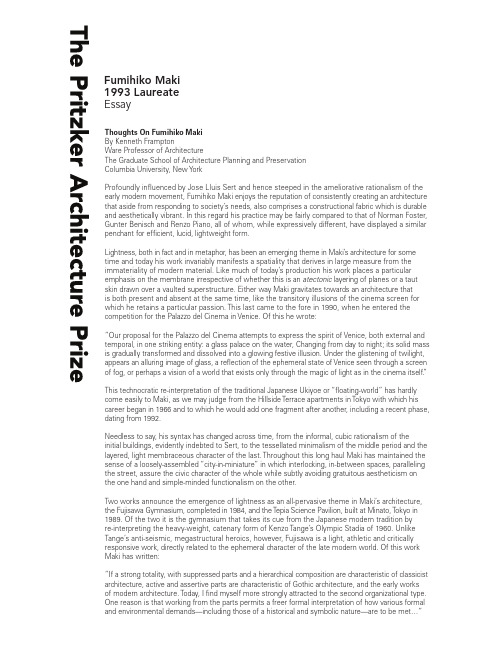
Fumihiko Maki1993 LaureateEssayThoughts On Fumihiko MakiBy Kenneth FramptonWare Professor of ArchitectureThe Graduate School of Architecture Planning and PreservationColumbia University, New Y orkProfoundly influenced by Jose Lluis Sert and hence steeped in the ameliorative rationalism of the early modern movement, Fumihiko Maki enjoys the reputation of consistently creating an architecture that aside from responding to society’s needs, also comprises a constructional fabric which is durable and aesthetically vibrant. In this regard his practice may be fairly compared to that of Norman Foster, Gunter Benisch and Renzo Piano, all of whom, while expressively different, have displayed a similar penchant for efficient, lucid, lightweight form.Lightness, both in fact and in metaphor, has been an emerging theme in Maki’s architecture for some time and today his work invariably manifests a spatiality that derives in large measure from the immateriality of modern material. Like much of today’s production his work places a particular emphasis on the membrane irrespective of whether this is an atectonic layering of planes or a taut skin drawn over a vaulted superstructure. Either way Maki gravitates towards an architecture thatis both present and absent at the same time, like the transitory illusions of the cinema screen for which he retains a particular passion. This last came to the fore in 1990, when he entered the competition for the Palazzo del Cinema in Venice. Of this he wrote:”Our proposal for the Palazzo del Cinema attempts to express the spirit of Venice, both external and temporal, in one striking entity: a glass palace on the water, Changing from day to night; its solid mass is gradually transformed and dissolved into a glowing festive illusion. Under the glistening of twilight, appears an alluring image of glass, a reflection of the ephemeral state of Venice seen through a screen of fog, or perhaps a vision of a world that exists only through the magic of light as in the cinema itself.”This technocratic re-interpretation of the traditional Japanese Ukiyoe or “floating-world” has hardly come easily to Maki, as we may judge from the Hillside Terrace apartments in Tokyo with which his career began in 1966 and to which he would add one fragment after another, including a recent phase, dating from 1992.Needless to say, his syntax has changed across time, from the informal, cubic rationalism of the initial buildings, evidently indebted to Sert, to the tessellated minimalism of the middle period and the layered, light membraceous character of the last. Throughout this long haul Maki has maintained the sense of a loosely-assembled “city-in-miniature” in which interlocking, in-between spaces, paralleling the street, assure the civic character of the whole while subtly avoiding gratuitous aestheticism on the one hand and simple-minded functionalism on the other.Two works announce the emergence of lightness as an all-pervasive theme in Maki’s architecture, the Fujisawa Gymnasium, completed in 1984, and the T epia Science Pavilion, built at Minato, T okyo in 1989. Of the two it is the gymnasium that takes its cue from the Japanese modern tradition byre-interpreting the heavy-weight, catenary form of Kenzo Tange’s Olympic Stadia of 1960. Unlike Tange’s anti-seismic, megastructural heroics, however, Fujisawa is a light, athletic and critically responsive work, directly related to the ephemeral character of the late modern world. Of this work Maki has written:”If a strong totality, with suppressed parts and a hierarchical composition are characteristic of classicist architecture, active and assertive parts are characteristic of Gothic architecture, and the early worksof modern architecture. Today, I find myself more strongly attracted to the second organizational type. One reason is that working from the parts permits a freer formal interpretation of how various formal and environmental demands—including those of a historical and symbolic nature—are to be met…”Thoughts On Fumihiko Maki(continued)2Elsewhere he will write of the profile of Fujisawa as symbolizing through its sharp but simultaneously soft outline the fundamental ambiguity of the modern world. However Fujisawa will only be the firstin a series of such thin shell structures in which layered, crustaceous membranes of stainless steel are carried on long-span steel trusses, grounded in concrete podia. Within this development both the Makuhari Messe, built at Chiba in 1989 and the Tokyo Municipal Gymnasium of 1990 are equally dematerialized shell structures of a similar order.Through such hovering forms, Maki has been able to render his concept of a fragmentary urbanism at a higher symbolic level, in which these modern “cathedrals” stand out against the chaos of the Megalopolis as civic catalysts. The highly reflective shell roofs of Fujisawa and Makuhari imply, at vastly different scales, a new kind of urban enclave with which to engender and sustain a more fluid and shifting conception of public space. With its 540 meter-long undulating metal roof (40 meters short of Paxton’s Crystal Palace) and its 120 meter span, the Makuhari Exhibition Hall dwarfs the two-way, shell roofed spans of the Fujisawa and Tokyo gymnasiums, so that one spontaneously associates its vastness with such mega-engineering works as the George Washington Bridge. Its length is such that the various ancillary structures running down its side, entry-foyer, events hall, etc., recall nothing so much as so many tugboats at the side of a transatlantic liner.If the ultimate point of departure for Fujisawa Gymnasium resides in the Gothic, the Tepia Pavilion finds its parti in the Rietveld/Schroeder House of 1924 and in Le Corbusier’s Villa Shodan of 1956. And yet while Maki is indebted to these canonically modern paradigms for the overall planar, pin-wheeling, form assumed by the pavilion, the underlying order is classic, even if the implicit cubic mass and the regular columnar grid never fully materialize. Thus unlike the Iwasaki Museum andhis own house, dating from the late 1970s, where an asymmetrical mass is stabilized about an axis,T epia establishes its center of gravity in relation to a small triangular occulus set in the center of its main facade. While Tepia is planned like a palazzo about an “atrium,” little of this classicism prevailsin the overall spatial organization, so that it both evokes and denies the classic to an equal degree. If, as Serge Lalat has argued, Maki proceeds by a process of crystallization, he also undermines this procedure by simultaneously engaging in an act of dematerialization. This is particularly true of his orthogonal works, such as Tepia, where the detailing of the fenestration, tends to dissolve the surface into which it is set. Thus, notwithstanding Maki’s unwavering commitment to programmatic rationality, the final expression is subtly mannered. It is, as Arata Isozaki once put it, an architectureof quotation par excellence, so that Tepia recalls not only Reitveld and Le Corbusier, but also Walter Gropius; in particular the thin-oversailing roofs and transparent cylindrical stair towers of Gropius’ Werkbund Building of 1914.Whether Maki is tectonic as in the Fujisawa, or atectonic as in Tepia, the dematerialization of the surface persists throughout and in this regard, Maki’s work may be compared to that of Carlo Scarpa, wherein as Manfred Tafuri once put it, “one is confronted by a perverse dialectic between the celebration of form and the scattering of its parts.” And yet while Maki is willing to acknowledge his proximity to Scarpa, he also evokes an immaterial spirituality that seems totally removed from the tactile, ontological depth that is so characteristic of Scarpa’s architecture. In each instance a common cross-cultural collagiste strategy is employed, to quite different ends; Scarpa being as much influenced by the East, as Maki has been touched by the West. However, Maki’s mode of synthesis is quite unique for while his Wacoa Building combines elements drawn to an equal degree from the occident and orient, the synthesis of the two is achieved through the tradition of sukiya. This same procedure may be found in the Tepia Building only at a higher level of resolution. In taking its distance from the aristocratic tradition of the shoin, the sukiya manner opened itself to a wider and more heterogeneous assembly of different values. This sense of eclectic subversion, endemic to the sukiya style, appears as Kazuhiro Ishii has pointed out, in the categoric departure of Tepia from the parti the Villa Shodan.”The transformation from the concrete of the Villa Shodan to high-tech metal, breaks abruptly with the contradictory traditional theories of the past. Symbolic of the break are the sharp corners, which relateThoughts On Fumihiko Maki(continued)3to the beveling of corners (hakkake) practiced in sukiya buildings, to make posts and alcove framework members look more slender.”Unlike most of his contemporaries Maki unites within his practice two rather contradictory positions; on the one hand an ethical commitment to the provision of an architecture that is both rational and appropriate, on the other, an ironic disposition capable of acknowledging the aporias of the modern world and of confronting the ever-escalating implosion of information and development. Maki regards the inescapably disjunctive character of this last with a dispassionate, Olympian eye. Generous to a fault, he will acknowledge that the programmatic indifference of Deconstructivist Architecture as an understandable reaction to the schismatic character of our time. At the same time he remains detached and judicious, resisting, without becoming reactionary, the temptation to indulge in the plastic and iconographic excesses of the younger generation. Instead his work is informed by a disconcerting and contradictory combination of anxiety and optimism. On the one hand he remains extremely skeptical, while, on the other, he projects the Blochian idea of hope; the famous “not yet” of the Weimar Republic.There is surely no non-Gallic architect who is more French than Fumihiko Maki for one cannot look at his career or listen to his words without being reminded of the French intellectual tradition at its best. Master architect and mandarin he turns his face towards technology in the belief that this apocalyptical demiurge carries within itself the sole seeds of our salvation. While maintaining a playful and ironic stance, Maki insists that only thought is transferable, so that when one thinks of his impeccable self-discipline one is irresistibly reminded of Le Corbusier’s immortal words: “The man who is intelligent, cold and calm has grown wings to himself.”© The Hyatt FoundationFor more information, please contact:Martha Thorne, Executive DirectorThe Pritzker Architecture Prize71 South Wacker DriveSuite 4700Chicago, Illinois 60606email: marthathorne@。
岛精公司介绍

⏭⮊㚨⧞ᮢ ⟌⍋㚨⧞ᱹ
㱸㯐㲂☼㎲☨ 㸏㺑㊹
㐩⒱㨻♋ㅚ⧻⍌⫒
㐩⒱㨻♋ㅚ⧻⍌⫒
㐩⒱㨻♋ㅚ⧻⍌⫒
㐩⒱㨻♋ㅚ⧻⍌⫒
SWG® 061N
㔋㔩㽐ᮢ㐷㽳 ᱶMACH2®X
ӈæ
满足市场需求的最尖端技术
活跃在世界市场的电脑横编机, 在便于操作的基础上加之发挥其高效、多功能性, 并以更广领域的产品阵容实现了更高时装性的针织产品的生产。
ᅡ൜๖
㱱〉⤇㙶㋵⪆☨㾎㨰㬥㊹☨㝗≦
㽼⤇㙶㽻⧩㔤⭜㺲㨲☨㷝㖸㝲 SHIMA SEIKI DESIGN CENTER OF HONG KONGᱤ㺲⥖ᱥ SHIMA SEIKI DESIGN CENTER OF SHANGHAIᱤ㺲⥖ᱥ
SHIMA SEIKI DESIGN CENTER OF NEW YORKᱤよ⥖ᱥ SHIMA SEIKI DESIGN CENTER OF MILANOᱤ㯌▙⺉ᱥ Tokyo Communication Spaceᱤ㑓〉ᱥ
Ⴜၴಭ
ᯱ㯜㢜㣐⟌⧩✚㦫ⓥ十㲓⬷⟔☨ㄬ⏫⡮ᱨⲳ㦄㱭よ㝛㨻 ᯱ㺬☼㑟㑫ᮢ㎡⌍ᱨ▞⹂⒔㐸☨㗠㗄⡮⧧⧩㔩⡮ ᯱ⳱㱸㦄㻚☨㔨㚭㩂ᱨ㱸⺉㲂㔩㝛⫆⛑
Ⴜၴ׀
ᯱ㩖㮔㖫ᱨ㺝㔶㚱㩖⮔㗷 ᯱ㺝㩖㖳㱫㾎㔕八☨㓰㦏ᱨ⭞㖛㽪㴚㱾⪏⌏
⍌㺑⏦㊮ ᱤ⏭⮊ᮢ⟌⧩ᱥ
⏭⮊㚨⧞ᮢ ⟌⍋㚨⧞
⒱㨻⍌㺑
⟌⍋㚨⧞
WHOLEGARMENT® 㐩⒱㨻
在东京晴海举行的国际针织机械展览会 中展出全自动手套编织机和全自动半成型 横编机, 正式进升为横编机制造商。
开发全自动无缝手套编织机 SFG。
在法国巴黎举行的国际纺织机械 展览会 (ITMA)中展出所有的机种, 广受国际好评, 正式开始向国外出口。
全自动手套编织机 FAC
介绍一个自己喜欢的国家英文作文
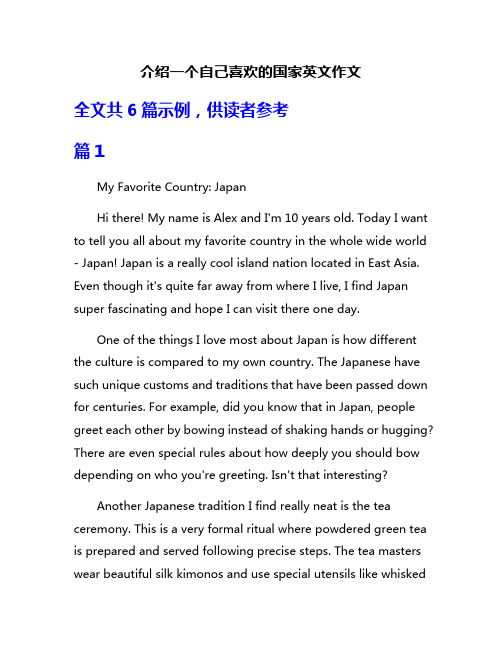
介绍一个自己喜欢的国家英文作文全文共6篇示例,供读者参考篇1My Favorite Country: JapanHi there! My name is Alex and I'm 10 years old. Today I want to tell you all about my favorite country in the whole wide world - Japan! Japan is a really cool island nation located in East Asia. Even though it's quite far away from where I live, I find Japan super fascinating and hope I can visit there one day.One of the things I love most about Japan is how different the culture is compared to my own country. The Japanese have such unique customs and traditions that have been passed down for centuries. For example, did you know that in Japan, people greet each other by bowing instead of shaking hands or hugging? There are even special rules about how deeply you should bow depending on who you're greeting. Isn't that interesting?Another Japanese tradition I find really neat is the tea ceremony. This is a very formal ritual where powdered green tea is prepared and served following precise steps. The tea masters wear beautiful silk kimonos and use special utensils like whiskedand bowls. Everything is done slowly and gracefully. I think participating in a real tea ceremony would be such a cool cultural experience.Speaking of kimonos, I'm obsessed with traditional Japanese clothing! Kimonos are full-length robes made out of ornate fabric like silk. The fanciest ones have gorgeous patterns with flowers, landscapes or geometric designs. Japanese women also style their hair in elaborate updos accessorized with kanzashi hair ornaments. The kimonos and hairstyles look like walking works of art to me!Another super awesome facet of Japanese culture is the food. Let me tell you, Japanese cuisine is out of this world! Obviously, there's sushi which is rice and fresh fish rolled up in seaweed. But there's also ramen (noodle soup), yakisoba(stir-fried noodles), okonomiyaki (savory pancakes), yakitori (skewered chicken) and so much more. The Japanese even have amazing sweet treats like mochi (pounded sticky rice cakes), daifuku (sweet rice balls), and my personal favorite - creamy, flavorful matcha green tea ice cream! Just typing this is making my mouth water.What really sets Japan apart though are the landscapes and scenery. Because the country is made up of islands, it hasincredibly diverse forests, mountains, coastlines and more. In the spring, Japan is famous for its beautiful cherry blossom trees that cover areas in pale pink blooms. During fall, the maple trees turn brilliant shades of red, orange and yellow. It looks like a real-life painting! Then there are the iconic Mount Fuji, bubbling hot springs, neon-lit cities of Tokyo...I could go on and on. Basically, Japan has some of the most picturesque natural and man-made sights in the entire world.Speaking of Tokyo, Japan's capital definitely deserves a mention. Tokyo is the largest and most populous city on the planet with over 37 million residents in the greater metro area! It's known for its amazing skyline, shopping, restaurants and just the general energy and excitement around every corner. The streets and neighborhoods of Tokyo are where traditional Japan meets ultra-modern. You'll see centuries-old temples and shrines right alongside soaring skyscrapers covered in flashing neon signs and video screens. It's such a cool and vibrant city that I'd love to explore one day.As you can probably tell by now, I'm completely fascinated by Japanese language and culture. From the incredibly polite social etiquette to the intricate arts and pop culture...Japan just seems like such an endlessly interesting place. While thetraditions are very different from my own lifestyle, I have so much respect and appreciation for how the Japanese take such pride in their rich heritage.What really solidified my love for Japan though was getting to host a Japanese exchange student who attended my school for a year. Her name was Sakura and she taught me so much about her home country. We became great friends and I got to experience bits of Japan firsthand through her - celebrating holidays, eating authentic home-cooked meals, learning simple Japanese phrases, and more. Sakura was an amazing ambassador and she really brought Japan to life for me in a personal way.I feel so fortunate that despite living across the world, I've been exposed to Japanese culture through TV, books, video games, friends and more. It has given me such an appreciation for the country's one-of-a-kind history, customs, natural beauty and way of life. Studying world cultures is one of my favorite subjects in school and Japan is always at the top of my list when it comes to fascinating societies.My biggest dream is to be able to travel to Japan for real one day and experience it all with my own eyes. I want to wander through bamboo forests and Shinto shrines, see a Sumowrestling match, shop in the trendy Harajuku district, ride a bullet train, celebrate festivals, and of course sample as much Japanese food as I possibly can! Who knows, maybe I could even learn to become a katana sword master or anime voice actor - a kid can dream, right?Well, those are just some of the reasons why Japan is my favorite country. Between the friendly people, intriguing traditions, spectacular nature, entertaining pop culture, and amazing cuisine...what's not to love? Japan has worked its way into my heart and I can't wait to hopefully visit this East Asian island nation one day. For now, I'll just have to continue being a kawaii Japan superfan from afar. Arigato gozaimasu (thank you very much) for letting me share my appreciation for the Land of the Rising Sun!篇2My Favorite Country: Italy!Hi there! My name is Jamie and I'm 10 years old. Today I want to tell you all about my favorite country in the whole wide world - Italy! I went there on vacation with my family a couple years ago and it was seriously the best trip ever. Get readybecause I'm going to tell you everything that makes Italy so incredibly amazing.First up, the food in Italy is out of this world delicious! I'm talking next level yummy. You've probably had pizza and pasta before, but let me tell you, the real Italian stuff is a million times better than anything you've tasted. In Italy, they make their pizza with the freshest ingredients like tomatoes that were just picked from the garden, yummy cheeses, and delicious meats. The crusts are perfectly crispy on the outside but doughy and chewy on the inside. Mmmmm...just thinking about it makes my mouth water!And don't even get me started on the pasta. Italians are true pasta experts and make it from scratch using fresh eggs, premium semolina flour, and a sprinkle of magic (okay, maybe not magic but it sure tastes that way!). My favorite was the cheese tortellini in a rich, creamy sauce. But no matter what kind of pasta you order, it will be tender yet have the perfect al dente bite. So incredibly delizioso!Apart from the amazingly tasty food, another awesome thing about Italy is the incredibly beautiful cities and buildings. It's like being transported back in time to centuries ago. The architecture is mind-blowing with huge stone castles, medievalchurches with painted ceilings, and plazas lined with fountains and statues. Everything is so intricate and ornate.One of the coolest places I went was the Roman Colosseum. This giant amphitheater is almost 2000 years old but still partly intact! Can you imagine people fighting lions and gladiators battling here ages ago? It was spine-tinglingly cool to walk through the arched tunnels and steep steps, and stand in the middle visualizing the intense fights that happened there. I felt like a true Roman for a day!Speaking of Romans, Italy has tons of awesome historical sites leftover from that ancient empire like ruined temples, bathhouses, and roads. My little brother and I had a blast pretending to be noble Roman kids frolicking in the forums and royal palaces. We probably annoyed our parents with all the farting sound effects but they were good sports about it!Another place I adored was the canals of Venice. This city is completely surrounded by water so there are no cars - just winding waterways and gondola boats. Our family took a iconic gondola ride along the narrow canals while an Italian guy in a striped shirt and hat serenaded us. It was pretty cheesy but also totally romantic!Venice is also famous for its blown glass, and we watched a master glassblower make a horse sculpture from scratch. It was so cool to see the molten glass being delicately shaped and transformed into a colorful work of art right before our eyes. I don't know how he didn't burn himself!Of course no trip to Italy is complete without a stop at the Leaning Tower of Pisa! I won't lie, we absolutely had to get one of those cheesy pictures where it looks like we're holding up or kicking over the tilted tower. Cliche tourist photo? You bet! But it was still mega fun.I could keep gushing about Italy forever but I better wrap this up. Just know that Italy has the most delectable food, incredible historical sights, romantic cities, and friendly people around. The culture, scenery, and overall vibe of the country is truly special. I really hope I can go back again sometime and explore even more of that bellissima place! Ciao for now!篇3My Favorite Country - Italy!Do you know what my favorite country is? It's Italy! Italy is a boot-shaped peninsula in Southern Europe, and it's just the coolest place ever. Let me tell you all about it!First of all, Italy has the most amazing food. Pizza was invented in Italy, and you can get the most delicious authentic pizza pies there. The dough is perfectly chewy, the sauce is rich and tomatoey, and the mozzarella cheese melts into scrumptious gooey perfection. My mouth is watering just thinking about it! But pizza isn't the only incredible Italian food. There's also pasta (my favorite is spaghetti carbonara with egg, pancetta, and parmesan), gelato (Italian ice cream that's richer and creamier than any other ice cream), and so many other yummy dishes. I could eat Italian food every day and never get bored!Speaking of eating, another thing I love about Italy is that people there seem to really appreciate and enjoy food. Meals aren't just something to rushed through - they're social events where you linger over multiple courses with family and friends. Eating is celebrated as one of life's great pleasures in Italy. What could be better than that?The scenery in Italy is just breathtaking too. There are glittering blue seas, cliffs with colorful villages perched on top, rolling green hills with vineyards and olive groves, and majestic snowy mountain peaks. Cities like Venice, Florence, and Rome have gorgeous Renaissance architecture with frescoed churches, romantic bridges over canals, and grand piazzas. And don't evenget me started on the art - Italy has more famous artworks and sculptures than anywhere else, including masterpieces by Michelangelo, Raphael, Botticelli, and Leonardo da Vinci. The entire country is basically one big outdoor museum!Italians themselves are another huge reason why I adore Italy so much. In my experience, they are warm, friendly people who really know how to enjoy life. Family is extremely important in Italian culture, and you'll often see big multi-generational families gathering together, chatting animatedly, and having a great time. Italians love to celebrate, whether it's major holidays like Christmas and Easter, or just getting together for big Sunday pranzi (lunches). There always seems to be a party, festival, or celebration of some kind happening. And Italians are also famous for their hand gestures and expressive communication style. It's impossible not to get swept up in their vibrant energy!Even the climate in Italy is pretty amazing. With hot, sunny summers and mild winters, it has that perfect Mediterranean weather. You can lounge on the beach, go for hikes, or just spend time outdoors in the gorgeous piazzas eating gelato almost every day of the year. Sign me up!I hope you can see why Italy is my hands-down favorite country on the planet. Between the incredible food, stunningscenery, fascinating history, friendly culture, and wonderful weather, Italy has something for everyone to love. It's the total package! The only downside is that it's pretty far away, so I don't get to visit as often as I'd like. But I dream about going back constantly. After all, as the Italian saying goes: "All roads lead to Rome!" Maybe I'll be lucky enough to live out my dream of moving to Italy when I'm older. Fingers crossed! Ciao for now!篇4My Favorite Country: JapanHi there! My name is Emma, and I'm a 10-year-old girl who loves learning about different countries and cultures. Today, I want to tell you about my favorite country in the whole wide world – Japan!Japan is an amazing island nation located in East Asia. It's made up of four main islands: Honshu, Hokkaido, Kyushu, and Shikoku. The capital city of Japan is Tokyo, which is one of the biggest and most exciting cities I've ever seen! With its towering skyscrapers, neon lights, and bustling streets, Tokyo is a true modern marvel.One of the things I love most about Japan is its rich history and culture. Did you know that Japan has a long tradition ofsamurai warriors? These brave soldiers lived by a code of honor called "bushido" and were known for their skill with the sword. I find the samurai fascinating, and I love learning about their legends and heroic deeds.Another aspect of Japanese culture that fascinates me is the art of origami. Origami is the ancient Japanese art of paper folding, and it's amazing to see how a simple sheet of paper can be transformed into intricate shapes and figures. I've tried my hand at origami, and it's not as easy as it looks! But I love the challenge, and I'm determined to master it one day.Japan is also famous for its delicious cuisine. From sushi and ramen to teriyaki and tempura, Japanese food is a true delight for the senses. My favorite Japanese dish is probably yakisoba, which is a delicious stir-fried noodle dish with vegetables and meat. Yum!One of the things that amazes me about Japan is its natural beauty. From the stunning cherry blossom trees that bloom in spring to the majestic Mount Fuji, Japan is a country that truly celebrates and appreciates nature. I dream of one day visiting the Japanese Alps and hiking through the breathtaking mountain scenery.Speaking of nature, Japan is also home to some incredible wildlife. One of my favorite Japanese animals is the red-crowned crane, a beautiful and graceful bird that is considered a symbol of luck and longevity in Japanese culture. I would love to see these magnificent creatures in their natural habitat one day.But Japan isn't just about history, culture, and nature – it's also a technological powerhouse! Japanese companies like Sony, Nintendo, and Toyota are world leaders in electronics, gaming, and automotive innovation. I'm constantly in awe of the incredible gadgets and gizmos that come out of Japan.One of the things that truly sets Japan apart is its unique blend of tradition and modernity. You can be walking through a bustling, high-tech city one moment, and then stumble upon a serene, centuries-old temple the next. This harmonious coexistence of old and new is one of the things that makes Japan so fascinating to me.I could go on and on about all the things I love about Japan, but I'll wrap things up by saying that Japan is a country that truly captures my imagination. From its rich cultural heritage to its cutting-edge technology, Japan is a place篇5My Favorite Country: JapanHi everyone! Today I want to tell you all about my favorite country in the whole world - Japan! Japan is a really cool place with lots of fun things to see and do. I first learned about Japan in school and ever since then I've been totally obsessed with it. Get ready because I'm going to tell you everything I know!First off, Japan is an island country located in East Asia. That means it's surrounded by water which is pretty neat. It's made up of four main islands - Honshu, Hokkaido, Kyushu, and Shikoku. The capital city is Tokyo which is on the island of Honshu. Tokyo is a massive, bustling city that never sleeps! With over 37 million people living there, it's one of the most populated cities in the world. I can only imagine how crowded and exciting it must be.One of the coolest things about Japan is its unique culture that has been around for thousands of years. The Japanese people are really proud of their traditions and history. For example, there are beautiful shrines and temples all across Japan where people go to pray and practice ancient rituals. My favorite is the Fushimi Inari Shrine in Kyoto which has thousands of bright orange torii gates snaking up a mountain side. It looks like something straight out of a fantasy movie!The Japanese also have fascinating customs when it comes to things like clothing, art, and food. You may have seen pictures of geisha, who are traditional Japanese entertainers. They wear incredibly elaborate kimonos and style their hair and makeup in such an intricate way. Japanese art is renowned worldwide, from the delicate brush paintings to the bold woodblock prints. I'm absolutely in awe of how talented the artists are.As for food, Japan is famous for its delicious sushi and ramen noodles. But they also have lots of other tasty dishes like yakisoba (fried noodles), okonomiyaki (savory pancakes), and onigiri (rice balls). The Japanese put a huge emphasis on using fresh, seasonal ingredients and presenting the food in a visually stunning way. I've tried making sushi at home before but it's really hard and never looks as good as what you get in Japan!Another thing I love about Japan is how advanced and modern the country is when it comes to technology. Japan is a global leader in robotics, video games, anime, and all sorts of cutting-edge innovations. Who doesn't love Super Mario, Pokemon, and hi-tech Japanese cars and electronics? At the same time, the Japanese are deeply rooted in tradition so you have this awesome mix of very old and very new things coexisting. It's such a unique place!The Japanese also excel at so many other things that I'm interested in - martial arts (like judo and karate), zen gardens,J-pop music, kawaii culture, you name it! No matter what you're into, I'm sure you could find some aspect of Japan that would fascinate you. There's just something incredibly unique and special about this small island nation that draws me in.While Japan may seem like an exotic, faraway place, I'm determined to visit there one day. Can you imagine how incredible it would be to wander through the neon-lit streets of Tokyo, watch a ninja show, see a Sumo wrestling match, visit Hiroshima and learn about its tragic history, go hiking up Mount Fuji, and try the most amazing Japanese foods? It would be a dream came true for this Japan-obsessed kid.Even if I can't make it to Japan anytime soon, I'm perfectly content surrounding myself with Japanese things here at home. I love collecting samurai swords (don't worry, they're fake!), practicing karate, learning Japanese phrases, and absorbing as much as I can about this rich culture. Maybe I'll grow up to be a manga artist, video game designer, or even teach the Japanese language. Who knows!Well, I could honestly go on forever about why Japan is so awesome but I think you get the idea by now. Hopefully afterreading this you're a little bit intrigued too and want to learn more! Japan is hands-down my favorite country ever and I doubt that will change anytime soon. The mix of ancient traditions and modern innovations makes Japan endlessly fascinating to me. If you ever get the chance to visit or explore Japanese culture, I highly recommend you take it - you won't be disappointed! Thanks for letting me geek out about the coolest country on Earth!篇6My Favorite Country: JapanHi there! My name is Emma, and I'm going to tell you all about my favorite country in the whole wide world – Japan! Japan is a fascinating place with a rich culture, delicious food, and so many cool things to see and do. I've always been fascinated by Japan ever since I was a little kid, and I can't wait to share my love for this amazing country with you.First off, let's talk about the food in Japan. Oh my goodness, Japanese cuisine is simply out of this world! From themelt-in-your-mouth sushi to the comforting bowls of ramen, Japanese food is a true delight for the taste buds. One of my favorite Japanese dishes is okonomiyaki, which is a savorypancake filled with all sorts of delicious ingredients like cabbage, meat, and a special sauce. Yum! And let's not forget about the desserts – Japanese sweets like mochi (rice cakes) and wagashi (traditional confections) are absolutely divine.Another thing I love about Japan is its stunning natural beauty. From the towering Mount Fuji to the tranquil gardens and parks, Japan is a true paradise for nature lovers. One of my dreams is to visit the famous cherry blossom festivals, where the streets and parks are lined with beautiful pink cherry blossom trees. Can you imagine how magical that must be? I also really want to explore the ancient forests and hike through the picturesque mountains.Japan is also known for its fascinating history and culture. I'm always in awe when I learn about the samurai warriors, the elegant geisha traditions, and the intricate art forms like origami and calligraphy. Japanese people have such a deep respect for their heritage, and it's truly inspiring. I love how they blend traditional customs with modern life so seamlessly.Speaking of modern life, Japan is also a hub of technology and innovation. From cutting-edge robots to mind-blowing video games and anime, Japan is at the forefront of so many cool advancements. I'm obsessed with Japanese anime and manga,and I can spend hours getting lost in the vibrant worlds and characters they create. And let's not forget about the quirky and fun side of Japanese pop culture, like the crazy game shows and kawaii (cute) fashion trends.One thing that really fascinates me about Japan is the concept of wabi-sabi, which is the appreciation of imperfection and transience. I love how Japanese people celebrate the beauty in simple, imperfect things and find joy in the fleeting moments of life. It's such a refreshing perspective, and it really resonates with me.As you can probably tell, I'm absolutely smitten with Japan. From the mouthwatering cuisine to the breathtaking landscapes, the rich traditions, and the cutting-edge technology, Japan truly has something for everyone. I can't wait until I'm old enough to visit this incredible country and experience all its wonders firsthand. Until then, I'll keep learning about Japan, practicing my Japanese language skills, and dreaming of the day I can finally explore the Land of the Rising Sun.。
最喜欢的西方服饰英语作文
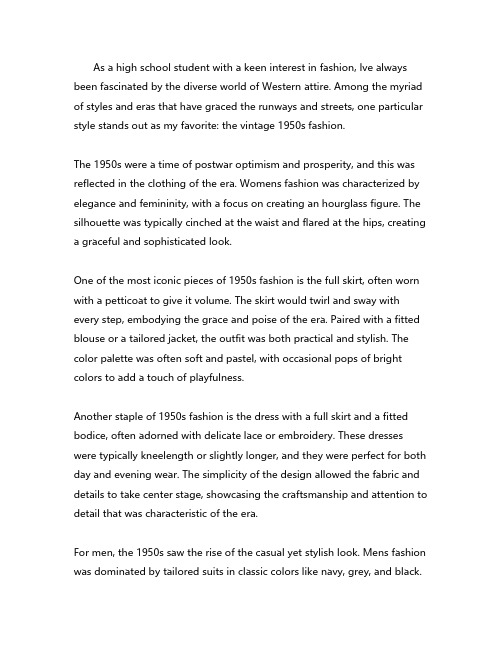
As a high school student with a keen interest in fashion, Ive always been fascinated by the diverse world of Western attire. Among the myriad of styles and eras that have graced the runways and streets, one particular style stands out as my favorite: the vintage 1950s fashion.The 1950s were a time of postwar optimism and prosperity, and this was reflected in the clothing of the era. Womens fashion was characterized by elegance and femininity, with a focus on creating an hourglass figure. The silhouette was typically cinched at the waist and flared at the hips, creating a graceful and sophisticated look.One of the most iconic pieces of 1950s fashion is the full skirt, often worn with a petticoat to give it volume. The skirt would twirl and sway with every step, embodying the grace and poise of the era. Paired with a fitted blouse or a tailored jacket, the outfit was both practical and stylish. The color palette was often soft and pastel, with occasional pops of bright colors to add a touch of playfulness.Another staple of 1950s fashion is the dress with a full skirt and a fitted bodice, often adorned with delicate lace or embroidery. These dresses were typically kneelength or slightly longer, and they were perfect for both day and evening wear. The simplicity of the design allowed the fabric and details to take center stage, showcasing the craftsmanship and attention to detail that was characteristic of the era.For men, the 1950s saw the rise of the casual yet stylish look. Mens fashion was dominated by tailored suits in classic colors like navy, grey, and black.The suits were often paired with a crisp white shirt and a tie, creating a polished and professional appearance. The era also saw the popularity of casual wear, with men donning denim jeans and leather jackets for a more relaxed look.One of the most distinctive aspects of 1950s fashion is the attention to accessories. Women often wore gloves, hats, and scarves to complete their outfits, adding an extra layer of sophistication. Men, on the other hand, often wore fedoras or trilby hats, along with a pocket square to add a touch of flair to their suits.The 1950s also saw the rise of iconic fashion designers like Christian Dior, who introduced the New Look in 1947, which became a defining feature of the era. His designs were characterized by their emphasis on the waist and the use of luxurious fabrics, setting the tone for the decades fashion.In conclusion, the 1950s fashion is my favorite because it embodies a sense of elegance, sophistication, and optimism that is often missing in todays fastpaced world. The attention to detail, the focus on craftsmanship, and the timeless designs make it a style that continues to inspire and captivate me. Whether its the full skirts, the tailored suits, or the delicate accessories, the 1950s fashion is a testament to the enduring appeal of classic style.。
岛精电脑横机

Computerized Flat Knitting Machine with Tandem Capability607070Shimatronic, Knitran and DSCS are registered trademarks of Shima Seiki Mfg., Ltd.Shima Seiki maintains a policy of continuous improvement for its products, and therefore specifications and appearances are subject to change without notice.Please contact your nearest authorized sales representative for the latest information.OPTIONS : (1) Fixed sinker system (7~12G ). (2) Spring-type moveable full-sinker system (14&16G ). (3) DSCS ®. (4) Right side yarn feed roller. (5) CE Mark.TypeKnitting width Tandem widthGauge Knitting speed Stitch densityRacking Knitting systemTransfer Stitch presser Sinker systemNeedle selection Takedown deviceDSCS®Side tension Yarn carriers Top tensionsStop motion Drive systemCleaner Safety devices5Operation lampData input Pattern memory Control system Control display Back-up powerPower3.5” floppy disk. USB memory interface. 10/100 BASE -T network.12,582,912 bits (1,024 wales 腾4,096 addresses )Stored program for flat knitting machine.Monochrome LCD panel. Editing possible via display panel operation. Available in English, French, Italian, Spanish, Portuguese, German, Turkish, Chinese, Korean and Japanese.Power supply for resuming knitting after power failure.3 phase AC200V 腽10% 2.0KVANewSES202-SVariable stroke. Max 80" (203cm )37" (94cm )腾27 . 8 . 10 . 12 . 14 . 16Max 1.3m/sec. (16G: 1.2m/sec.) Knitting speed varies according to gauge and knitting condition. Variably adjustable speed levels. 10 additional programmable speeds.60 levels, electronically controlled.Motor-driven racking mechanism. Max 2-inch racking. 1/2 and1/4 pitch also available from any position.Single KNITRAN ®system. Twin carriage.Simultaneous transfer, front or back, independent of carriage direction. Split stitch.Special motor-driven system allows individual adjustment for on/off in knit and transfer. Programmable press amount.7~12G : Spring-type moveable full-sinker system 114 &16G : Fixed sinker 2Full jacquard selection via special solenoid actuators.Main roller : Changeable 31 levels, automatically adjustable on each level.Sub roller : Changeable 31 levels, automatically adjustable on each level. Automatic opening and closing.Option.3 Consistent loop length by digital control method. Left side. Left side yarn feed roller.4 Yarn feed: 8 positions.8 on each side 12 carriers16 tension devices. One-touch easy threading. Large knots cause machine stop.Small knots cause 0-9 courses at specified knot detection speed, then automatically resume at set speed.Yarn break, large knot, wraparound check, shock detection, piece count, over-torque, program error, etc.Belt drive. AC servo motor. No lubrication necessary.Special blower operated cleaner.Full safety cover for noise-suppression and dust-proofing with stop motion sensor and interlock mechanism. Stop button. Power supply disconnecting device. Ultra-low speed “crawl” setting. Indicator lamps (see below ).Green/normal operation. Flashing green/normal stop. Flashing amber/abnormal stop.215022903270224054966516066585530136020152050490490All dimensions are in millimeters.Average WeightNewSES202-S 1,234kg (2,735 lb.)Actual weight is dependent upon gauge and optional equipment.In order to ensure safe operation of the equipment, please review all operation manuals carefully before use.NewSES202-SPrinted in JapanSHIMA SEIKI MFG., LTD.85 Sakata Wakayama JapanTEL +81-73-474-8210 FAX +81-73-474-8270SHIMA SEIKI EUROPE, LTD.Sills Road, Willow Farm Business Park,Castle Donnington, Derbyshire DE74 2US U.K.TEL 01332-814770 FAX 01332-850272SHIMA SEIKI U.S.A., INC.22 Abeel Road Monroe Twp., New Jersey 08831, U.S.A.TEL 609-655-4788 FAX 609-655-8463SHIMA SEIKI MFG., LTD., TAIPEI BRANCH1F, 30, Lane 583, Ruey Kuang Rd., Neihu, Taipei 114, TAIWAN R.O.C.TEL 886-2-8752-3388 FAX 886-2-8797-5522URL http://www.shimaseiki.co.jp Email info@shimaseiki.co.jpDIMENSIONSSPECIFCATIONSCONTROLLERSAFETY NOTICE。
四针床电脑横机全成形技术研究进展
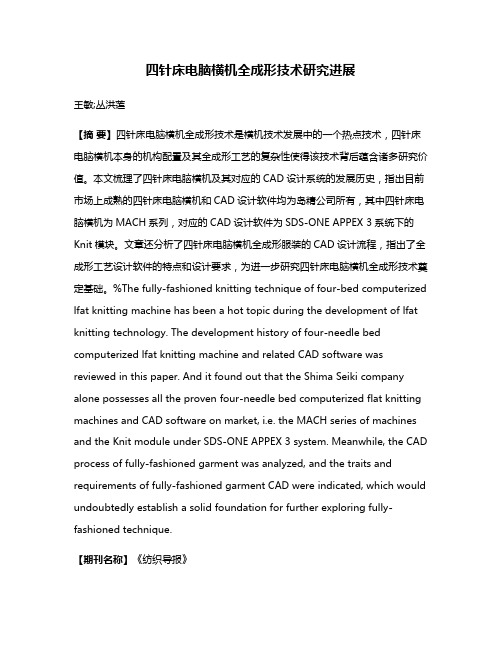
四针床电脑横机全成形技术研究进展王敏;丛洪莲【摘要】四针床电脑横机全成形技术是横机技术发展中的一个热点技术,四针床电脑横机本身的机构配置及其全成形工艺的复杂性使得该技术背后蕴含诸多研究价值。
本文梳理了四针床电脑横机及其对应的CAD设计系统的发展历史,指出目前市场上成熟的四针床电脑横机和CAD设计软件均为岛精公司所有,其中四针床电脑横机为MACH系列,对应的CAD设计软件为SDS-ONE APPEX 3系统下的Knit模块。
文章还分析了四针床电脑横机全成形服装的CAD设计流程,指出了全成形工艺设计软件的特点和设计要求,为进一步研究四针床电脑横机全成形技术奠定基础。
%The fully-fashioned knitting technique of four-bed computerized lfat knitting machine has been a hot topic during the development of lfat knitting technology. The development history of four-needle bed computerized lfat knitting machine and related CAD software was reviewed in this paper. And it found out that the Shima Seiki company alone possesses all the proven four-needle bed computerized flat knitting machines and CAD software on market, i.e. the MACH series of machines and the Knit module under SDS-ONE APPEX 3 system. Meanwhile, the CAD process of fully-fashioned garment was analyzed, and the traits and requirements of fully-fashioned garment CAD were indicated, which would undoubtedly establish a solid foundation for further exploring fully-fashioned technique.【期刊名称】《纺织导报》【年(卷),期】2016(000)009【总页数】5页(P96-100)【关键词】四针床电脑横机;全成形;package;压缩花样;展开花样【作者】王敏;丛洪莲【作者单位】江南大学教育部针织技术工程研究中心;江南大学教育部针织技术工程研究中心【正文语种】中文【中图分类】TS184.5四针床电脑横机全成形技术指的是在四针床电脑横机上织造无需进行裁剪和缝制等后处理工艺的三维立体织物的一项电脑横机成形先进技术,由于是在机上一体成形,故可以降低人力成本,且由于产品本身的无缝连接,加强了针织产品本身具有的舒适性以及合体性。
KNITTING OF FABRIC WITH POCKET
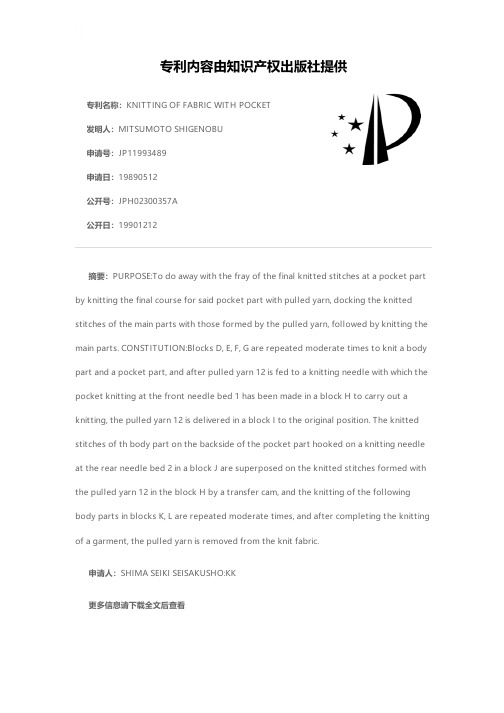
专利名称:KNITTING OF FABRIC WITH POCKET 发明人:MITSUMOTO SHIGENOBU申请号:JP11993489申请日:19890512公开号:JPH02300357A公开日:19901212专利内容由知识产权出版社提供摘要:PURPOSE:To do away with the fray of the final knitted stitches at a pocket part by knitting the final course for said pocket part with pulled yarn, docking the knitted stitches of the main parts with those formed by the pulled yarn, followed by knitting the main parts. CONSTITUTION:Blocks D, E, F, G are repeated moderate times to knit a body part and a pocket part, and after pulled yarn 12 is fed to a knitting needle with which the pocket knitting at the front needle bed 1 has been made in a block H to carry out a knitting, the pulled yarn 12 is delivered in a block I to the original position. The knitted stitches of th body part on the backside of the pocket part hooked on a knitting needle at the rear needle bed 2 in a block J are superposed on the knitted stitches formed with the pulled yarn 12 in the block H by a transfer cam, and the knitting of the following body parts in blocks K, L are repeated moderate times, and after completing the knitting of a garment, the pulled yarn is removed from the knit fabric.申请人:SHIMA SEIKI SEISAKUSHO:KK更多信息请下载全文后查看。
KNITTING METHOD FOR KNITTING FABRIC AND KNITTED PR
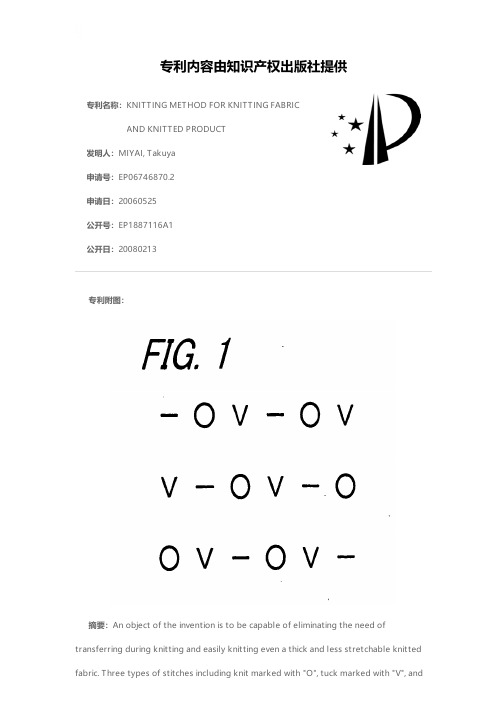
专利名称:KNITTING METHOD FOR KNITTING FABRICAND KNITTED PRODUCT发明人:MIYAI, Takuya申请号:EP06746870.2申请日:20060525公开号:EP1887116A1公开日:20080213专利内容由知识产权出版社提供专利附图:摘要:An object of the invention is to be capable of eliminating the need oftransferring during knitting and easily knitting even a thick and less stretchable knitted fabric. Three types of stitches including knit marked with "O", tuck marked with "V", andmiss marked with "-" are knitted repeatedly in a course direction and a wale direction. The fabric of a knitted product is 1.5 or more times as thick as plain stitched fabric and is as thick as a rib knitted fabric. The fabrics are stretchable to approximately 1.5 times and are approximately half as stretchable as the plain stitched fabric and are approximately half as stretchable as the plain stitched fabric that is stretchable to approximately 3 times. The fabrics are stretchable to approximately 1.7 to 1.8 times, and are as stretchable as the plain stitched fabric. Each course for knitting the knitted fabrics can be knitted by repeatedly knitting the three types of stitches of knit, tuck, and miss, so that transferring is not necessary in the course of knitting, and the knitted fabrics can be easily knitted that are thick and less stretchable in the horizontal direction.申请人:SHIMA SEIKI MANUFACTURING LIMITED地址:85 Sakata Wakayama-shi, Wakayama 641-8511 JP国籍:JP代理机构:Emde, Eric更多信息请下载全文后查看。
KNITTING METHOD FOR KNITTING FABRIC AND KNITTED PR
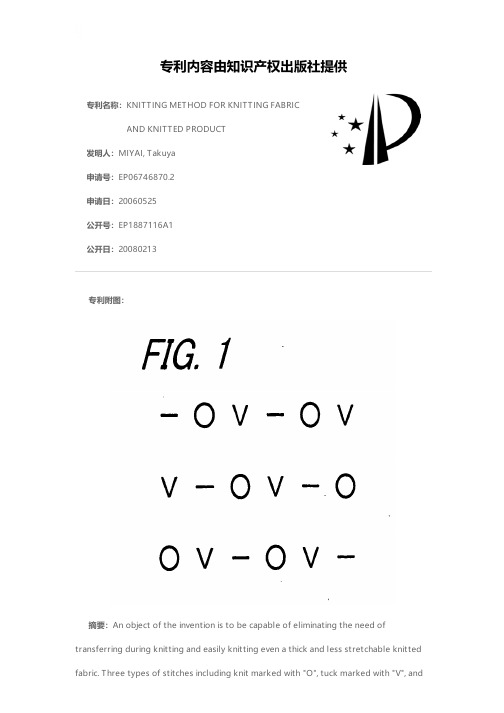
专利名称:KNITTING METHOD FOR KNITTING FABRICAND KNITTED PRODUCT发明人:MIYAI, Takuya申请号:EP06746870.2申请日:20060525公开号:EP1887116A1公开日:20080213专利内容由知识产权出版社提供专利附图:摘要:An object of the invention is to be capable of eliminating the need oftransferring during knitting and easily knitting even a thick and less stretchable knitted fabric. Three types of stitches including knit marked with "O", tuck marked with "V", andmiss marked with "-" are knitted repeatedly in a course direction and a wale direction. The fabric of a knitted product is 1.5 or more times as thick as plain stitched fabric and is as thick as a rib knitted fabric. The fabrics are stretchable to approximately 1.5 times and are approximately half as stretchable as the plain stitched fabric and are approximately half as stretchable as the plain stitched fabric that is stretchable to approximately 3 times. The fabrics are stretchable to approximately 1.7 to 1.8 times, and are as stretchable as the plain stitched fabric. Each course for knitting the knitted fabrics can be knitted by repeatedly knitting the three types of stitches of knit, tuck, and miss, so that transferring is not necessary in the course of knitting, and the knitted fabrics can be easily knitted that are thick and less stretchable in the horizontal direction.申请人:SHIMA SEIKI MANUFACTURING LIMITED地址:85 Sakata Wakayama-shi, Wakayama 641-8511 JP国籍:JP代理机构:Emde, Eric更多信息请下载全文后查看。
是否复兴汉服英语作文高中
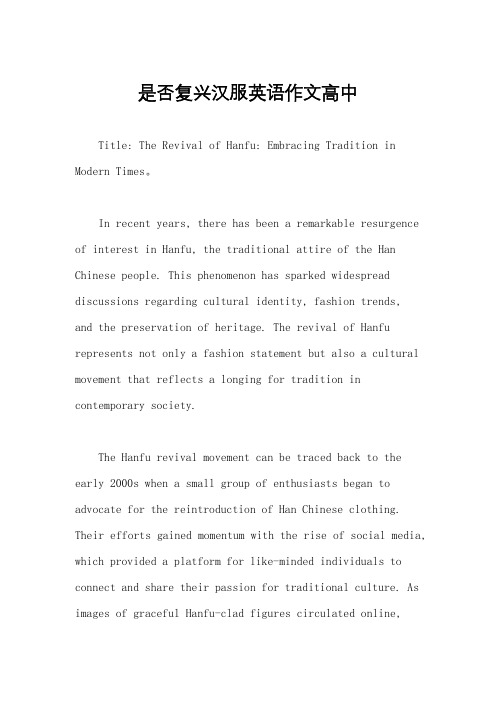
是否复兴汉服英语作文高中Title: The Revival of Hanfu: Embracing Tradition in Modern Times。
In recent years, there has been a remarkable resurgence of interest in Hanfu, the traditional attire of the Han Chinese people. This phenomenon has sparked widespread discussions regarding cultural identity, fashion trends,and the preservation of heritage. The revival of Hanfu represents not only a fashion statement but also a cultural movement that reflects a longing for tradition in contemporary society.The Hanfu revival movement can be traced back to the early 2000s when a small group of enthusiasts began to advocate for the reintroduction of Han Chinese clothing. Their efforts gained momentum with the rise of social media, which provided a platform for like-minded individuals to connect and share their passion for traditional culture. As images of graceful Hanfu-clad figures circulated online,more people became curious about this ancient attire, leading to a surge in its popularity.One of the driving forces behind the revival of Hanfuis the desire to reclaim cultural identity. In an era dominated by globalization and Western influence, many young Chinese people feel disconnected from their own heritage. By donning Hanfu, they not only express pride in their ancestry but also assert their cultural distinctiveness in a rapidly changing world. For them, wearing Hanfu is more than just putting on a costume; it is a statement of belonging and cultural continuity.Furthermore, the revival of Hanfu has sparked a renewed interest in traditional craftsmanship and textile arts. Many enthusiasts are not only passionate about wearing Hanfu but also about reviving the traditional techniques used to create it. From hand-weaving silk fabric to embroidering intricate patterns, artisans are rediscovering and preserving these ancient skills, ensuring that they are passed down to future generations. In doing so, they are not only honoring the past but also contributing to therevitalization of traditional craftsmanship in contemporary society.Moreover, the resurgence of Hanfu has had a significant impact on the fashion industry. Designers are increasingly drawing inspiration from traditional Chinese aesthetics, incorporating elements of Hanfu into their creations. This fusion of tradition and modernity has resulted in a unique style that resonates with people both in China and around the world. By embracing Hanfu, fashionistas are not only making a fashion statement but also promoting cross-cultural exchange and appreciation.However, the revival of Hanfu has also faced criticism and challenges. Some argue that it romanticizes the past and overlooks the social inequalities and injustices that existed during ancient times. Others worry that it promotes cultural chauvinism and nationalism, exacerbating tensions between different ethnic groups within China. Additionally, there are concerns about the commercialization of Hanfu, with some companies exploiting the trend for profit without regard for its cultural significance.Despite these challenges, the revival of Hanfu continues to thrive, driven by the passion and dedication of its enthusiasts. Whether it's through social media campaigns, cultural events, or grassroots initiatives, the Hanfu movement shows no signs of slowing down. In an increasingly globalized world, where cultural identities are constantly evolving, the resurgence of Hanfu serves as a reminder of the importance of preserving and celebrating one's heritage.In conclusion, the revival of Hanfu represents a cultural reawakening that transcends mere fashion trends. It is a testament to the enduring power of tradition in shaping contemporary society. By embracing Hanfu, people are not only honoring the past but also shaping the future, creating a world where tradition and modernity can coexist harmoniously. As the Hanfu movement continues to gain momentum, it reminds us of the richness and diversity of Chinese culture, inspiring people around the world to explore and appreciate their own cultural heritage.。
以女性百年来服装变化为主题的作文
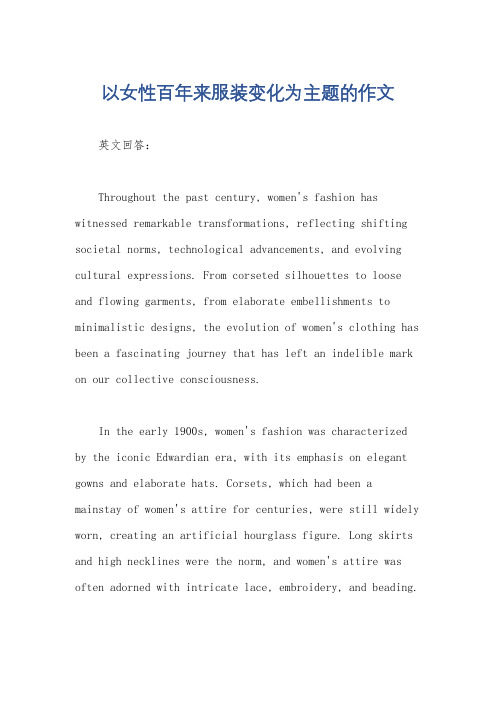
以女性百年来服装变化为主题的作文英文回答:Throughout the past century, women's fashion has witnessed remarkable transformations, reflecting shifting societal norms, technological advancements, and evolving cultural expressions. From corseted silhouettes to loose and flowing garments, from elaborate embellishments to minimalistic designs, the evolution of women's clothing has been a fascinating journey that has left an indelible mark on our collective consciousness.In the early 1900s, women's fashion was characterized by the iconic Edwardian era, with its emphasis on elegant gowns and elaborate hats. Corsets, which had been a mainstay of women's attire for centuries, were still widely worn, creating an artificial hourglass figure. Long skirts and high necklines were the norm, and women's attire was often adorned with intricate lace, embroidery, and beading.As the 1920s dawned, a new era of liberation and modernity swept through women's fashion. The flapper silhouette, with its dropped waistlines and shorter skirts, became a symbol of rebellion against traditional beauty standards. Women began to ditch their corsets and embrace a more boyish look, with cloche hats, bobbed hair, and androgynous tailoring.The 1930s saw a return to more feminine silhouettes, with long, flowing gowns and bias-cut skirts becoming popular. The bias cut, which involved cutting fabric on the diagonal, allowed for garments to drape beautifully on the body. Women's clothing also began to incorporate moreprints and patterns, as well as bold colors and geometric designs.During World War II, women's fashion took a more practical turn. With men away fighting in the war, women entered the workforce in record numbers, and their clothing reflected their new roles. Shorter skirts, pantsuits, and utilitarian jumpsuits became commonplace, as women sought garments that were both comfortable and functional.The postwar era witnessed a resurgence of glamour and femininity in women's fashion. Dior's "New Look," with its full skirts, cinched waists, and nipped-in shoulders, became the epitome of chic. Women also embraced ultra-feminine accessories, such as pearls, gloves, and heels.The 1960s and 1970s were a time of great experimentation and change in women's fashion. The youth counterculture movement rejected the formality and conservatism of the previous decades, and women began to embrace more eclectic and carefree styles. Miniskirts,bell-bottom jeans, and colorful tie-dye became popular, as did ethnic-inspired clothing and accessories.In the 1980s, women's fashion became synonymous with power dressing. Shoulder pads, bold colors, and tailored suits were all the rage, as women sought to project an image of confidence and competence in the workplace. The rise of the supermodel also had a significant impact on fashion, with women like Cindy Crawford and Naomi Campbell becoming household names.The 1990s saw a return to minimalism and grunge. Women began to embrace more casual and comfortable clothing, such as jeans, t-shirts, and hoodies. Grunge fashion, inspired by the Seattle music scene, incorporated elements of androgyny, ripped fabrics, and plaid shirts.In the 21st century, women's fashion has become increasingly diverse and inclusive. The rise of social media and fast fashion has made it easier than ever for women to access a wide range of styles and trends. Sustainable fashion has also gained popularity, as women become more conscious of the environmental impact of their clothing choices.Today, women's fashion continues to evolve at a rapid pace, reflecting the constantly changing landscape of society and culture. From the resurgence of vintage trends to the emergence of new technologies, the future of women's fashion is full of possibilities.中文回答:在过去的一个世纪里,女性的着装发生了显著的变化,反映了不断变化的社会规范、技术进步和文化表达。
如今旗袍的应用英语作文
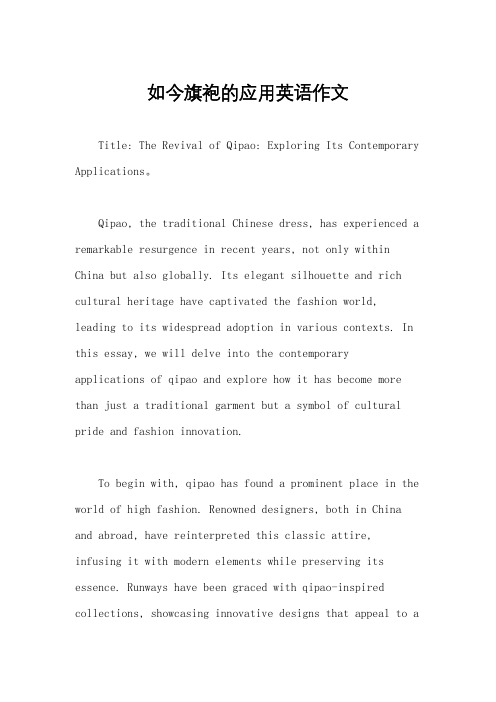
如今旗袍的应用英语作文Title: The Revival of Qipao: Exploring Its Contemporary Applications。
Qipao, the traditional Chinese dress, has experienced a remarkable resurgence in recent years, not only within China but also globally. Its elegant silhouette and rich cultural heritage have captivated the fashion world, leading to its widespread adoption in various contexts. In this essay, we will delve into the contemporaryapplications of qipao and explore how it has become more than just a traditional garment but a symbol of cultural pride and fashion innovation.To begin with, qipao has found a prominent place in the world of high fashion. Renowned designers, both in China and abroad, have reinterpreted this classic attire,infusing it with modern elements while preserving its essence. Runways have been graced with qipao-inspired collections, showcasing innovative designs that appeal to aglobal audience. By blending traditional craftsmanship with contemporary aesthetics, designers have elevated qipao to a new level of sophistication, making it a coveted choice for red carpet events and prestigious occasions.Furthermore, the versatility of qipao has contributed to its widespread adoption in everyday fashion. Beyond formal events, qipao has become a fashionable choice for women seeking a unique and elegant look in their daily lives. Its sleek silhouette and intricate detailing add a touch of refinement to casual settings, making it suitable for a variety of occasions. From stylish streetwear to chic office attire, qipao offers endless possibilities for self-expression, allowing individuals to embrace their cultural heritage with confidence and style.Moreover, the popularity of qipao has transcended geographical boundaries, gaining recognition on the global stage. Influential figures in the entertainment industry have been spotted wearing qipao at international events, sparking interest and admiration worldwide. Celebrities and fashion icons have embraced qipao as a symbol of culturalappreciation, using their platform to promote its beauty and significance. As a result, qipao has become synonymous with elegance and sophistication, representing not only Chinese tradition but also the universal appeal of timeless fashion.In addition to its aesthetic appeal, qipao carries profound cultural significance, serving as a symbol of Chinese identity and heritage. Through its intricate designs and symbolism, qipao embodies centuries oftradition and craftsmanship, reflecting the rich tapestry of Chinese culture. By wearing qipao, individuals pay homage to their roots and celebrate the enduring legacy of their ancestors. Moreover, qipao serves as a bridge between the past and the present, fostering cultural exchange and dialogue in an increasingly interconnected world.In conclusion, the revival of qipao represents more than just a fashion trend; it is a testament to the enduring allure of traditional craftsmanship and cultural heritage. From the runways of Paris to the streets of Shanghai, qipao has captured the imagination of peoplearound the world, transcending boundaries of time and space. Its contemporary applications reflect a fusion of tradition and innovation, offering a glimpse into the evolving landscape of global fashion. As we continue to embrace diversity and celebrate cultural heritage, qipao stands asa shining example of the beauty and resilience of Chinese culture.。
马面裙成为年轻人的新风向的英语作文
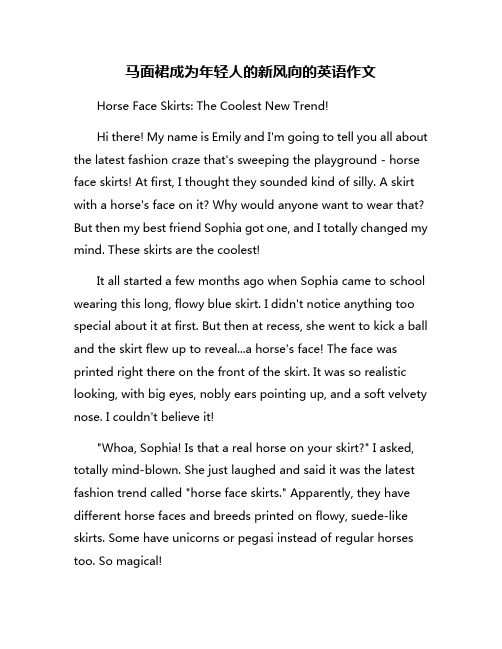
马面裙成为年轻人的新风向的英语作文Horse Face Skirts: The Coolest New Trend!Hi there! My name is Emily and I'm going to tell you all about the latest fashion craze that's sweeping the playground - horse face skirts! At first, I thought they sounded kind of silly. A skirt with a horse's face on it? Why would anyone want to wear that? But then my best friend Sophia got one, and I totally changed my mind. These skirts are the coolest!It all started a few months ago when Sophia came to school wearing this long, flowy blue skirt. I didn't notice anything too special about it at first. But then at recess, she went to kick a ball and the skirt flew up to reveal...a horse's face! The face was printed right there on the front of the skirt. It was so realistic looking, with big eyes, nobly ears pointing up, and a soft velvety nose. I couldn't believe it!"Whoa, Sophia! Is that a real horse on your skirt?" I asked, totally mind-blown. She just laughed and said it was the latest fashion trend called "horse face skirts." Apparently, they have different horse faces and breeds printed on flowy, suede-like skirts. Some have unicorns or pegasi instead of regular horses too. So magical!At first, I was a little weirded out by the idea of wearing a gigantic animal face on my clothes. But Sophia insisted I had to get one because they were just so awesome and fun to wear. After seeing how cute hers looked twirling around, I decided to keep an open mind.A few weeks later, it was my birthday, and my parents surprised me with a gorgeous sunflower yellow horse face skirt! The face on mine was a beautiful chestnut colored horse with a blonde mane and tail. I fell in love with it instantly. Putting it on and seeing that adorable face smiling up at me from my skirt was just the best feeling.From that day on, I wore my horse face skirt everywhere - to school, the park, birthday parties, you name it. They're so comfy and flowy, perfect for running and playing. But the real fun is getting to see the look on people's faces when the horse face part gets revealed!It's hilarious seeing little kids' eyes go wide when the skirt flies up and the horse face appears. Some get scared at first, thinking it's a real horse trapped under there! But as soon as they realize it's just a silly pattern, they always end up laughing and wanting to pet the skirt's soft horsey face.Even big kids and adults can't resist smiling when they see one of us frolicking around in our horse face skirts. I've had so many people stop me to ask where I got my skirt from. I always happily tell them about the brand Unicorn & Steed that makes them, so they can get some skirts of their own!Pretty soon, the horse face skirt trend really took off at my school. It started with just me and Sophia, but then a few other girls in our class got them. Before long, horses were galloping all over the hallways as more and more people jumped on the bandwagon. Recess became like a miniature horse race with a bunch of us running around, our colorful skirts and whinnying horse faces flowing behind us. So fun!But the skirts aren't just for girls - some of the boys started rocking them too! My friend Michael got one with a super cool black stallion face. He looks so majestic galloping across the soccer field with that powerful horse printed on his skirt. The really awesome thing about horse face skirts is that anyone can wear them, no matter your gender or age. They just bring a smile to everyone's face!I really think these skirts are more than just a passing fad too. For one thing, they're really well-made and built to last. The suede-like material is stretchy but super durable, and the printslook vibrant and brand new even after tons of washes. My parents tell me the company is also really eco-friendly and uses non-toxic dyes. So horse face skirts are as gentle on the earth as they are on horses!But I think the biggest reason horse face skirts are here to stay is because of how happy and free they make you feel. There's just something so joyful and whimsical about wearing a huge horse face that makes you feel like a playful kid again. You can't help but smile and want to run and twirl when you put one on. In a world that gets more technologic and serious every day, we all need that childlike sense of magic and fun. Horse face skirts give that back to us in a simple, beautiful way.So what are you waiting for? Gallop on over to your nearest clothing store and pick up a horse face skirt of your very own! With so many gorgeous designs to pick from - Clydesdales, Mustangs, Arabians, and more - you're sure to find your new favorite fashion pal. Get ready to bring some playful, carefree, horse-loving energy wherever you go. The horse face skirt movement is just getting started, and it's guaranteed to put a smile on anyone's face!。
旗袍英语四级作文
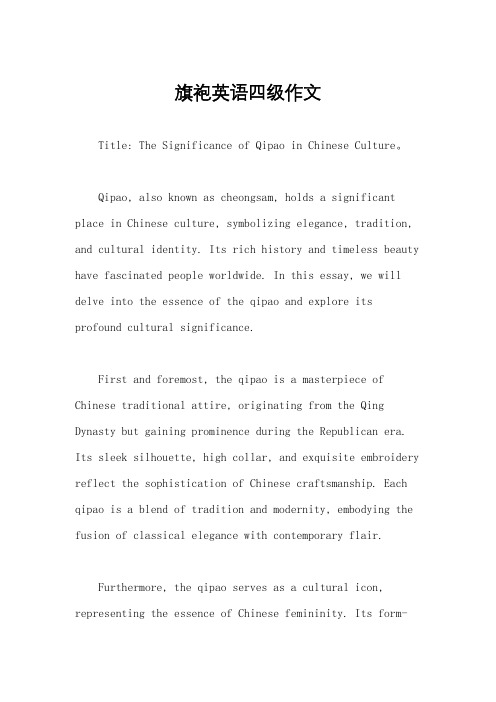
旗袍英语四级作文Title: The Significance of Qipao in Chinese Culture。
Qipao, also known as cheongsam, holds a significant place in Chinese culture, symbolizing elegance, tradition, and cultural identity. Its rich history and timeless beauty have fascinated people worldwide. In this essay, we will delve into the essence of the qipao and explore its profound cultural significance.First and foremost, the qipao is a masterpiece of Chinese traditional attire, originating from the Qing Dynasty but gaining prominence during the Republican era. Its sleek silhouette, high collar, and exquisite embroidery reflect the sophistication of Chinese craftsmanship. Each qipao is a blend of tradition and modernity, embodying the fusion of classical elegance with contemporary flair.Furthermore, the qipao serves as a cultural icon, representing the essence of Chinese femininity. Its form-fitting design accentuates the curves of the female body, exuding grace and charm. Wearing a qipao is not merely donning a piece of clothing; it is embracing a cultural heritage and celebrating womanhood in all its glory.Moreover, the qipao transcends mere fashion; it is a symbol of national pride and identity. In an increasingly globalized world, where cultural boundaries blur, the qipao stands as a beacon of Chinese tradition, preserving the legacy of generations past. Its popularity both domestically and internationally underscores its enduring appeal and cultural significance.Additionally, the qipao serves as a canvas for artistic expression, with its intricate designs and vibrant colors reflecting the diverse cultural landscape of China. From delicate floral patterns to elaborate motifs inspired by nature and mythology, each qipao tells a unique story, weaving together threads of tradition and innovation.Furthermore, the qipao plays a pivotal role in special occasions and cultural ceremonies, such as weddings,festivals, and formal events. Its presence adds a touch of elegance and grandeur to any occasion, making it a cherished garment for generations of Chinese women.In conclusion, the qipao epitomizes the beauty, grace, and cultural richness of China. Its timeless appeal and enduring legacy continue to captivate hearts around the world, serving as a testament to the enduring spirit of Chinese culture. As we celebrate the qipao, let us cherish its beauty, honor its heritage, and preserve its legacy for generations to come.。
电脑横机编织物起底藏拉头的工艺改进
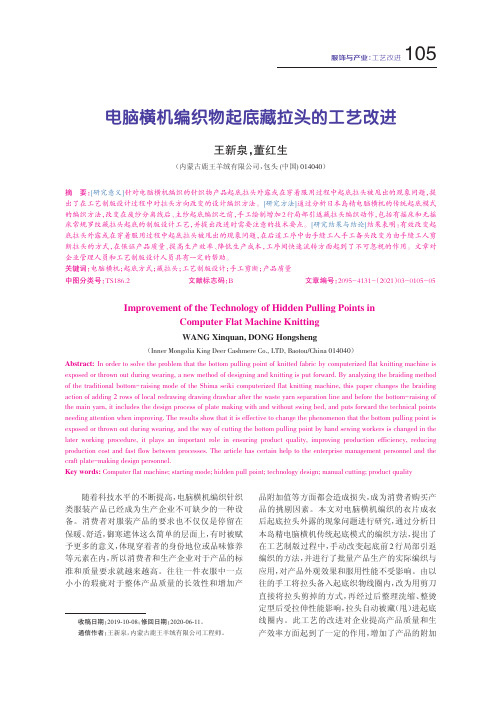
基本上是模块类型系统自带的、固定的。制版人员 织物最右列 1 针编织前板成圈组织,便于分离线的
在设计时,常规的起底模式系统软件基本都能够自 抽纱编织;
动生成,不用制版人员另外设计起底模式[3]。
1.1 日本岛精电脑横机传统起底模式(图 1)
在图 1 的 S6 编织工段中:带入 18 号导纱器在 织物最右列 1 针编织后板成圈组织,便于分离线的
设计系统型号为:SDS-ONE 设计系统、A51 设 计系统或 APEX3 设计系统。
标号说明:基于图 1(粗针型编织机 1-1 罗纹起 底模式,)说明上述岛精电脑横机传统起底模式的
抽纱编织; 在图 1 的 S7、S8 编织工段中:带入 8 号导纱器
按 1、3、5、7、9、11、13、15 后板成圈编织新线圈; 在图 1 的 S9、S10、S11 编织工段中:分别带 1 号导
105 服饰与产业:工艺改进
电脑横机编织物起底藏拉头的工艺改进
王新泉,董红生
(内蒙古鹿王羊绒有限公司,包头 (中国) 014040)
摘 要:[研究意义]针对电脑横机编织的针织物产品起底拉头外露或在穿着服用过程中起底拉头被甩出的现象问题,提 出了在工艺制版设计过程中对拉头方向改变的设计编织方法。[研究方法]通过分析日本岛精电脑横机的传统起底模式 的编织方法,改变在废纱分离线后、主纱起底编织之前,手工绘制增加 2 行局部引返藏拉头编织动作,包括有摇床和无摇 床常规罗纹藏拉头起底的制版设计工艺,并提出改进时需要注意的技术要点。[研究结果与结论]结果表明:有效改变起 底拉头外露或在穿着服用过程中起底拉头被甩出的现象问题,在后道工序中由手缝工人手工备头改变为由手缝工人剪 断拉头的方式,在保证产品质量、提高生产效率、降低生产成本,工序间快速流转方面起到了不可忽视的作用。文章对 企业管理人员和工艺制版设计人员具有一定的帮助。 关键词:电脑横机;起底方式;藏拉头;工艺制版设计;手工剪断;产品质量
Shima Seiki SWG-X WHOLEGARMENT
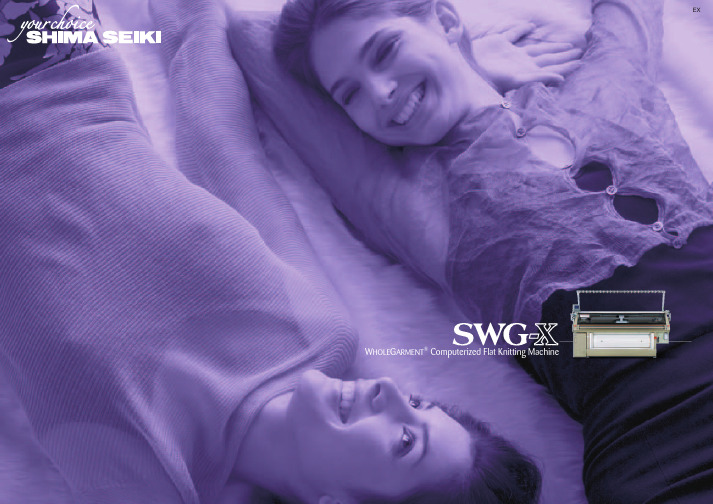
EXKnitting WidthBelt-Drive Operation Ultra-Lightweight CarriageToughNeedle BedGauge Range4-BedConfigurationW HOLE G ARMENT Knitting Electromagnetic Needle SelectionSlideNeedle™Stitch Presser Loop PresserYarn Gripper and Cutter DSCS i-DSCS 8G only;12&15G optional12&15G onlyDouble RackingW HOLE G ARMENT ® Computerized Flat Knitting Machinegured for W HOLE G ARMENT ® knitting with 4 needle beds and an additional loop presser ®-X features vast improvements over the original SWG ®-series machines. With ® “next generation” technology, the SWG ®-X is capable of HOLE G ARMENT ® products which conform perfectly to ®173-X’s capability, ranging from ned ultrafi ne gauge applications.HOLE G ARMENT ® KNITTING AVAILABLE.Setup Device PulldownDevice AutomaticDust CleanerSchedule Knit Back-LitLCD PanelNetworkInterfacePatternMemoryUSBMemoryInterfaceBack-UpPowerThe All-New SlideNeedle™Shima Seiki has reinvented the most basic element of knitting—the needle. The new SlideNeedle™ is the result of a thorough re-evaluation of the 150-year old design of the conventional latch needle, and offers knitting possibilities never imagined before. A fl exible two-piece slider mechanism splits and extends beyond the needle hook for in-creased potential especially in complex transfers. Using the slider mechanism for transfer effectively eliminates the transfer clip, allowing the needle to be mounted in the center of the needle groove. SlideNeedle™ thereby achieves perfectly sym-metrical loop formation for knitting the highest possible quality fabrics.Pulldown DeviceThe SWG®-X’s new computer-controlled takedown system consists of front and rear panels over which tiny pins are distributed for separately controlling takedown tension for the front and back when knitting W HOLE G ARMENT®. In addition, each panel is separated into 1.5-inch sections which can be individually controlled for specific tension control across the entire width of the garment. This precise control over takedown tension per-mits 3-dimensional shaping of W HOLE G ARMENT®items—for example, by allowing shoulder lines for set-in sleeves to be positioned over the shoulder toward the back—resulting in a more dimensionally accurate garment which conforms better to the shape of the torso.4-Bed Confi gurationThe SWG®-X, like the flagship FIR ST®, features SlideNeedle™ which are mounted on 4 needle beds, in effect attaching 2 extra beds on top of a conventional V-bed. This setup allows unprec-edented capabilities in knit and transfer, signifi -cantly expanding design and patterning capability in W HOLE G ARMENT® production. As a result, the SWG®-X is the only machine in the world which is capable of producing fi ne gauge W HOLE G ARMENT®knitwear with rib structures.i-DSCS®(8G: standard, 12&15G: optional)Available with SWG®-X is the i-DSCS® Digital StitchControl System with Intelligence. It carries over thebenefi ts of DSCS®, with even better performance.Whereas DSCS® is a passive system which controlsstitch length and yarn tension by limiting yarn-feed, i-DSCS® has the capability to actively controlyarn-feed in both feed and retrieval directions asnecessary, resulting in even higher quality andgreater productivity using a wider variety of yarns.Like its predecessor, i-DSCS® provides consistentquality among different production batches andrepeat orders, and is crucial to the precision knit-ting required in W HOLE G ARMENT® production.Air Splicer (optional)Unlike conventional knotter systems which me-chanically tie together yarn ends, the Air Splicercuts then twists together yarns with a burst ofpressurized air with split-second accuracy. Work-ing in precise coordination with our i-DSCS®Digital Stitch Control System with intelligence,the Air Splicer is able to time each splice so thatperfect color changes can occur exactly asprogrammed. With the Air Splicer, high-qualitymulti-color W HOLE G ARMENT® knitwear can beproduced easily and with beautiful results.SWG, WHOLEGARMENT, FIRST, DSCS, SlideNeedle and Shimatronic are either registered trademarks or trademarks of Shima Seiki Mfg., Ltd. in Japan and / or other countries.Shima Seiki maintains a policy of continuous improvement for its products, and therefore specifi cations and appearances are subject to change without notice.Please contact your nearest authorized sales representative for the latest information.SWG-X Printed in JapanType SWG ®173-X Gauge 8 · 12 · 15Knitting width Variable stroke. Max 68” (170cm )Knitting speed Max 1.3m ⁄ sec. Knitting speed varies according to various knitting conditions. Variably adjustable speed levels. 16 additional programmable speeds. Stitch density 120 levels, electronically controlled.Second stitchMotor-controlled second stitch cam allows individual adjustment of loose ⁄ tight stitches for shaping. Lower carriage only.Racking Motor-driven. Double racking. Max 1.5-inch racking in each direction (3 inches total) for all four needle beds and loop presser bed.Front:Racking of upper and lower front beds are performed as one.Rear:Racking of upper and lower rear beds and loop presser bed are performed as one.Knitting systemUltra-compact 3-system (1 knitting system + 2 transfer systems ). Single carriage.Transfer Lower beds: Simultaneous transfer, front and back, independent of carriage direction.Upper beds: Upper beds to opposite lower beds, independent of carriage direction.Sinker system Fixed sinker systemStitch presser Special motor-driven system allows individual on ⁄ off.Loop presser Individual selection and independent control. Loop presser bed positioned above upper rear needle bed. Needle selection Electromagnetic direct selection.Setup device Takedown comb with special setup needles.Pulldown deviceSpecial pulldown mechanism with independent operation of front and rear. Precise control over entire garment width in 1.5-inch increments.Exit rollers Special rollers for fabric pulldown and release. Consists of two rollers.Yarn cutter Single-unit system includes 1 yarn cutter and 2 yarn grippers. Both sides standard.Air SplicerInstant color changes using pressurized air. 8 colors per unit . Optional 1.DSCS®Consistent loop length by digital control method. Left side standard 2. Yarn feed roller on both sides standard (left side: double roller). 8 positions on each side. Left side yarn stopper device 3. 12 &15G only.i-DSCS ®DSCS ® with Intelligence. Actively controls yarn feed in both feed and retrieval directions. Both sides standard. Yarn feed roller on both sides standard. 16 positions. 8G only 4.Side tensions 12 on each side (8G : 16 on each side )Yarn carriers 12 carriersTop tensions 24 tension devicesOne-touch easy threading. Large knots cause machine stop. Small knots cause 0-9 courses at specified knot detection speed, then automatically resume at set speed.Stop motion Yarn break, large knot, wraparound check, shock detection, piece count, over-torque, program error, etc.Drive systemBelt drive. AC servo motor. No lubrication necessary.Cleaner Special blower-operated cleaner. Automatic operation available upon knitting a set number of pieces. Manual operation also available.Safety devices 5Full safety cover for noise-suppression and dust-proofing with stop motion sensor and interlock mechanism. Stop button. Power supply disconnecting device. Ultra-low speed “crawl” setting. Indicator lamps Operation lampGreen ⁄ normal operation. Flashing green ⁄ normal stop. Flashing amber ⁄ abnormal stop.Data input USB memory interface. USB 3.5” MO disk interface. Ethernet 10 ⁄ 100 BASE - T network interface.Pattern memory 50,331,648 bits (1,024 wales ×16,384 addresses )Control system Stored program for flat knitting machine.Control display Monochrome LCD panel. Editing possible via display panel operation. Available in English, French, Italian, Spanish, Portuguese, German, Turkish, and Japanese.Back-up powerPower supply for resuming knitting after power failure.Power3 phase AC200V ±10% 3.0KVAIn order to ensure safe operation of the equipment, please review all operation manuals carefully before use.SAFETY NOTICESHIMA SEIKI MFG.,LTD.85 Sakata Wakayama JapanTEL+81-73-474-8210FAX+81-73-474-8270SHIMA SEIKI EUROPE, LTD.Sills Road, Willow Farm Business Park,Castle Donington, Derbyshire DE74 2US U.K.TEL +44-1332-814770 FAX +44-1332-850272SHIMA-ORSI S.p.A.Via Redecesio 11, 20090 Redecesio Di Segrate, Milano, ITALY TEL +39-02-216621 FAX +39-02-2139410SHIMA SEIKI U.S.A., INC.22 Abeel Road, Monroe Twp., New Jersey 08831 U.S.A.TEL +1-609-655-4788 FAX +1-609-655-3989SHIMA SEIKI WIN WIN LTD.11/F Glory Industrial Building, 22 Lee Chung Street Chai wan HONG KONGTEL +852-2898-8339 FAX +852-2558-8332SHIMA SEIKI KOREA INC.337-6, Jangan 2-Dong,Dongdaemoon-Ku, Seoul KOREA 130-840TEL +82-2-2216-4057 FAX +82-2-2216-4711SHIMA SEIKI MFG., LTD., TAIPEI BRANCH1F, 30, Lane 583, Ruey Kuang Rd., Neihu, Taipei 11492, TAIWAN TEL +886-2-8752-3388 FAX +886-2-8797-5522URL http://www.shimaseiki.co.jp Email ******************.jp2,025417.5417.53,02017.580802,1257451,4302,108656206209396560Fully Fashioned High-Speed Knitting MachineCONTROLLERSPECIFICATIONSDIMENSIONSSWG173-X 1,484kg (3,265 lbs )Actual weight is dependent upon gauge and optional equipment.Average WeightOPTIONS : (1) Air Splicer. (2) Right side DSCS ®. (3) Right side yarn stopper device. (4) i-DSCS ®(12&15G only ). (5) CE Mark.All dimensions are in millimeters.。
旗袍英语作文模板四级
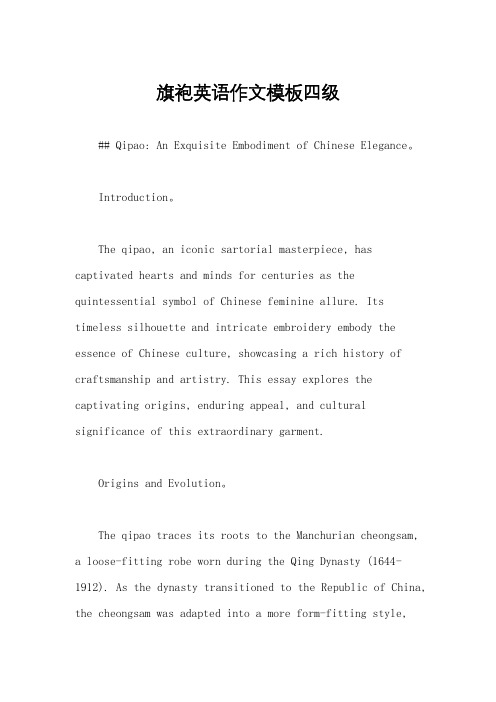
旗袍英语作文模板四级## Qipao: An Exquisite Embodiment of Chinese Elegance。
Introduction。
The qipao, an iconic sartorial masterpiece, has captivated hearts and minds for centuries as the quintessential symbol of Chinese feminine allure. Its timeless silhouette and intricate embroidery embody the essence of Chinese culture, showcasing a rich history of craftsmanship and artistry. This essay explores the captivating origins, enduring appeal, and cultural significance of this extraordinary garment.Origins and Evolution。
The qipao traces its roots to the Manchurian cheongsam, a loose-fitting robe worn during the Qing Dynasty (1644-1912). As the dynasty transitioned to the Republic of China, the cheongsam was adapted into a more form-fitting style,reflecting the changing social norms and Western influences. By the 1920s, the qipao had become an indispensable part of the modern Chinese woman's wardrobe, captivating audiences with its sleek lines and understated elegance.Distinctive Features。
岛精电脑横机

Computerized Flat Knitting Machine with Tandem Capability607070Shimatronic, Knitran and DSCS are registered trademarks of Shima Seiki Mfg., Ltd.Shima Seiki maintains a policy of continuous improvement for its products, and therefore specifications and appearances are subject to change without notice.Please contact your nearest authorized sales representative for the latest information.OPTIONS : (1) Fixed sinker system (7~12G ). (2) Spring-type moveable full-sinker system (14&16G ). (3) DSCS ®. (4) Right side yarn feed roller. (5) CE Mark.TypeKnitting width Tandem widthGauge Knitting speed Stitch densityRacking Knitting systemTransfer Stitch presser Sinker systemNeedle selection Takedown deviceDSCS®Side tension Yarn carriers Top tensionsStop motion Drive systemCleaner Safety devices5Operation lampData input Pattern memory Control system Control display Back-up powerPower3.5” floppy disk. USB memory interface. 10/100 BASE -T network.12,582,912 bits (1,024 wales 腾4,096 addresses )Stored program for flat knitting machine.Monochrome LCD panel. Editing possible via display panel operation. Available in English, French, Italian, Spanish, Portuguese, German, Turkish, Chinese, Korean and Japanese.Power supply for resuming knitting after power failure.3 phase AC200V 腽10% 2.0KVANewSES202-SVariable stroke. Max 80" (203cm )37" (94cm )腾27 . 8 . 10 . 12 . 14 . 16Max 1.3m/sec. (16G: 1.2m/sec.) Knitting speed varies according to gauge and knitting condition. Variably adjustable speed levels. 10 additional programmable speeds.60 levels, electronically controlled.Motor-driven racking mechanism. Max 2-inch racking. 1/2 and1/4 pitch also available from any position.Single KNITRAN ®system. Twin carriage.Simultaneous transfer, front or back, independent of carriage direction. Split stitch.Special motor-driven system allows individual adjustment for on/off in knit and transfer. Programmable press amount.7~12G : Spring-type moveable full-sinker system 114 &16G : Fixed sinker 2Full jacquard selection via special solenoid actuators.Main roller : Changeable 31 levels, automatically adjustable on each level.Sub roller : Changeable 31 levels, automatically adjustable on each level. Automatic opening and closing.Option.3 Consistent loop length by digital control method. Left side. Left side yarn feed roller.4 Yarn feed: 8 positions.8 on each side 12 carriers16 tension devices. One-touch easy threading. Large knots cause machine stop.Small knots cause 0-9 courses at specified knot detection speed, then automatically resume at set speed.Yarn break, large knot, wraparound check, shock detection, piece count, over-torque, program error, etc.Belt drive. AC servo motor. No lubrication necessary.Special blower operated cleaner.Full safety cover for noise-suppression and dust-proofing with stop motion sensor and interlock mechanism. Stop button. Power supply disconnecting device. Ultra-low speed “crawl” setting. Indicator lamps (see below ).Green/normal operation. Flashing green/normal stop. Flashing amber/abnormal stop.215022903270224054966516066585530136020152050490490All dimensions are in millimeters.Average WeightNewSES202-S 1,234kg (2,735 lb.)Actual weight is dependent upon gauge and optional equipment.In order to ensure safe operation of the equipment, please review all operation manuals carefully before use.NewSES202-SPrinted in JapanSHIMA SEIKI MFG., LTD.85 Sakata Wakayama JapanTEL +81-73-474-8210 FAX +81-73-474-8270SHIMA SEIKI EUROPE, LTD.Sills Road, Willow Farm Business Park,Castle Donnington, Derbyshire DE74 2US U.K.TEL 01332-814770 FAX 01332-850272SHIMA SEIKI U.S.A., INC.22 Abeel Road Monroe Twp., New Jersey 08831, U.S.A.TEL 609-655-4788 FAX 609-655-8463SHIMA SEIKI MFG., LTD., TAIPEI BRANCH1F, 30, Lane 583, Ruey Kuang Rd., Neihu, Taipei 114, TAIWAN R.O.C.TEL 886-2-8752-3388 FAX 886-2-8797-5522URL http://www.shimaseiki.co.jp Email info@shimaseiki.co.jpDIMENSIONSSPECIFCATIONSCONTROLLERSAFETY NOTICE。
旗袍英语四级作文
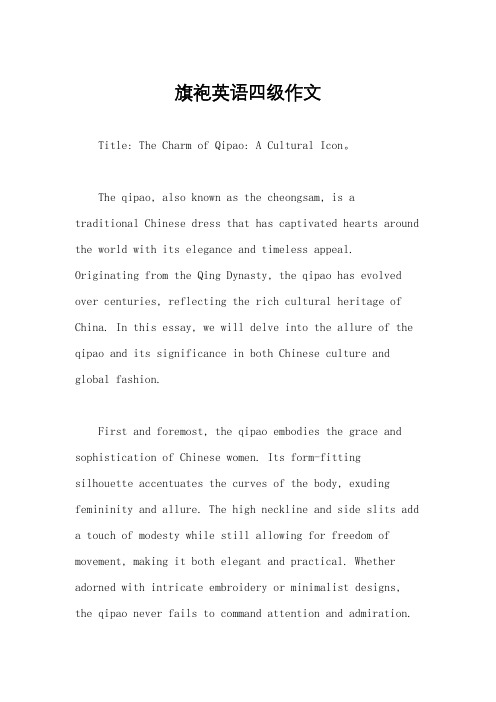
旗袍英语四级作文Title: The Charm of Qipao: A Cultural Icon。
The qipao, also known as the cheongsam, is atraditional Chinese dress that has captivated hearts around the world with its elegance and timeless appeal.Originating from the Qing Dynasty, the qipao has evolved over centuries, reflecting the rich cultural heritage of China. In this essay, we will delve into the allure of the qipao and its significance in both Chinese culture and global fashion.First and foremost, the qipao embodies the grace and sophistication of Chinese women. Its form-fittingsilhouette accentuates the curves of the body, exuding femininity and allure. The high neckline and side slits add a touch of modesty while still allowing for freedom of movement, making it both elegant and practical. Whether adorned with intricate embroidery or minimalist designs, the qipao never fails to command attention and admiration.Moreover, the qipao serves as a symbol of Chinese identity and cultural pride. Historically worn by women from all walks of life, it has transcended social boundaries to become a cultural icon synonymous with Chinese tradition. In today's globalized world, the qipao has gained popularity beyond China, with fashion enthusiasts and designers embracing its aesthetic appeal. Its incorporation into mainstream fashion showcases the beauty of Chinese culture and fosters cross-cultural appreciation and understanding.Furthermore, the qipao reflects the craftsmanship and artistry of Chinese artisans. Each qipao is meticulously crafted using luxurious fabrics such as silk, satin, and brocade, and adorned with exquisite details like hand embroidery and intricate patterns. The craftsmanship involved in creating a qipao is a testament to the skill and dedication of Chinese artisans, preserving age-old techniques passed down through generations. By supporting the production of qipaos, we not only celebrate Chinese craftsmanship but also contribute to the preservation oftraditional arts and culture.In addition, the qipao has undergone various reinterpretations and adaptations, ensuring its relevancein contemporary fashion. Modern designers have infused new elements into the traditional qipao, experimenting with different fabrics, cuts, and embellishments to create innovative designs that cater to diverse tastes and preferences. This fusion of tradition and modernitybreathes new life into the qipao, allowing it to remain a coveted fashion staple for generations to come.In conclusion, the qipao stands as a timeless symbol of elegance, cultural heritage, and craftsmanship. Itsenduring appeal transcends borders and generations, makingit a cherished garment beloved by people around the world. As we continue to celebrate the beauty of the qipao, let us also honor the rich cultural legacy it represents and preserve it for future generations to admire and appreciate.。
